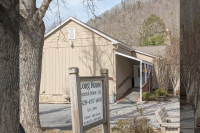The open water: Improved access, mapping set to spur water recreation in WNC
 It’s shaping up to be an exciting year for water-lovers in Western North Carolina.
It’s shaping up to be an exciting year for water-lovers in Western North Carolina.
After more than a decade of hydropower relicensing negotiations and years more of permitting and construction, Duke Energy is finishing a slate of river accesses that will make the Tuckasegee one of the most accessible rivers in the Southeast. At the same time, a collective effort to create an interactive map showing where and how to recreate on Western North Carolina waterways — using a tool called Smoky Mountain Blueways — is wrapping up, further boosting WNC’s future as a Mecca for outdoors lovers of all skill levels.
“I’m quite excited. It will be great for Jackson County, but it will also be great for the region,” said Lisa Leatherman, district manager for Duke Energy and a Macon County native. “The Tuck is now going that be one of the most accessible rivers in the Southeast. That’s huge.”
The lion’s share of the Tuck is in Jackson County, but the new focus on accessibility also encompasses waterways such as the Little Tennessee, Oconaluftee, Hiawassee and Nantahala rivers, as well as the reservoirs they connect with.
“At the most basic level, that builds the quality of life that the region has to offer,” said Mark Singleton, executive director of Sylva-based American Whitewater, one of the groups collaborating in the Blueways project. “At another level, it’s the appreciation of the outdoors that allows people to value them and think that rivers are important. If rivers are important to them, they care about them, they take care of them.”
Related Items
Opening up the river
Before Duke’s relicensing agreement spurred the development of more access points along the waterways from which it generates its power, there were only four places along the entire reach of the Tuckasegee which were built specifically to put in a canoe, kayak or raft. That number will soon reach 17, including reservoirs on the Tuckasegee, but that number doesn’t count the new accesses along the other rivers in the region.
Most of these river access points are now complete, though a few projects are ongoing. Duke is still waiting on permits from the state and the Tennessee Valley Authority to start work at the Lena Davis access, commonly called Cullowhee Dam, so that project isn’t expected to finish up until late autumn.
But besides that, there are just a few projects to finish up as spring approaches. Probably the most notable is the Pine Creek Access at Lake Glenville. There’s going to be a swimming area there — Duke drew down the reservoir so that crews could reconstruct the reservoir bottom to a more gradual slope — as well as a pump and haul toilet, picnic area, dock and handicapped-accessible walkway.
There’s also going to be a hiking trail, 0.8 miles of steep downhill into the canyon that houses 120-foot High Falls. By all accounts, it’s incredible, especially during wildflower season.
“You need to go to the High Falls Trail in March and April,” Leatherman said.
“It’s drop dead spectacular,” Singleton agreed, calling the trail construction of harvested rocks “incredible.”
Other than that, there’s just the paving job to finish at Bear Creek Lake once the weather warms up.
Blueways
But even before those touches are all in place, WNC will have the info at its fingertips as the Blueways project launches in the coming weeks.
Blueways is related to Duke’s recent ramping up of access points, but it’s about more than just Duke. Rather, it’s about collating all the accesses and recreation opportunities springing up along the waterways of WNC into one easy-to-use place.
“When the World Freestyle Games were here in September of 2013, it brought in an international audience,” said Leatherman. “It was a great way to bring attention to Western North Carolina, and my predecessor realized that.”
So, Duke awarded a $75,000 grant to develop Blueways, an effort spearheaded by Smoky Mountain Host and involving a diversity of other government, non-profit, and business groups on the Blueways Advisory Council,
“We have done massive research on access points on the rivers and will have in-depth info, including photos of the major public access points,” said Betty Huskins, executive director of Smoky Mountain Host. “This info will include type of fish in the stream, marina access, whether it is suited for tubing, kayaking, rafting, etc., and all other amenities in the area.”
In short, Blueways will be a compendium of all the places you can get out on the water, all the things you can do at each location, all the facilities you can use and what kind of environment you can expect to find there.
That includes a lot more than just Duke access points. For example, the N.C. Wildlife Resources Commission has installed accesses on its land, including at Needmore Game Lands in Macon and Swain counties, and the Macon County Greenway has access points of its own.
A tourism-driven region, Western North Carolina has plenty of organizations with an interest in helping people get out into nature. And plenty of people who would like to come visit said nature — with minimal planning necessary, please.
“Any time we can get a tool that we can leverage and promote, it’s great,” said Robert Jumper, chairman of the Jackson County tourism board.
And, Singleton pointed out, Blueways isn’t only about lakes and rivers.
“They’re not just river accesses,” he said. “They tie into other ways to interact with the river corridor.”
Ways like the wildlife viewing platform at Tanasee Creek Lake, the campsites at Bear Creek Lake and hiking trails at High Falls and Mission Lake.
The larger conversation
Dennis Desmond of Land Trust for the Little Tennessee pointed out that Blueways is also a chance for a larger conversation about the area’s resources and how those who love them can come together to keep them beautiful.
“I think it’s a great opportunity with this initiative to bring these partners together and have a more united vision of not just opening it up and letting people use it, but [asking], ‘How are we going to steward this resource?’ as well as education for the general public,” he said.
Good planning will be essential to ensuring that vision leads to a favorable end, LTLT Executive Director Sharon Taylor said.
“It’s all part of raising awareness,” Taylor said. “If you do raise awareness and more people come to use the resource, how do you accomplish that and how do you plan for it?”
That said, Taylor would like to see an emphasis on education going forward.
“Anyone who sees their water resources as a resource to be protected, that will have a positive impact on our work and conservation because then people want to conserve and keep the water pure,” she said. “No none wants to use a river that’s been degraded.”
Leatherman, meanwhile, is looking forward to a future formed by youth who grow up with an improved opportunity to understand that.
“If you are a little kid and just wanted to throw rocks in the river, you have a place to do that,” she said.
That’s thanks to improved access points. But thanks to improved publication of those access points, that hypothetical little kid’s parents will know where to take him to get outside.
“It’s good for folks in the region just to know what the region has to offer in opportunities to connect with nature and the outdoors,” Singleton said.
Get the info
Check www.smokymountainblueways.com over the coming weeks to explore all the ways to get out on — and around — the water in Western North Carolina. The online mapping tool will include in-depth information about all the water access points in the region, including photos, types of facilities and the kinds of recreation — and types of fish — each area best supports.
For now, information about each area of the region is available at www.visitsmokies.org/smoky-mountain-blueways.html.
A brochure detailing Duke Energy’s relicensing agreement and subsequently developed access points is available at www.duke-energy.com/pdfs/nantahala-area-rec-and-environ-enhancements-brochure.pdf.









